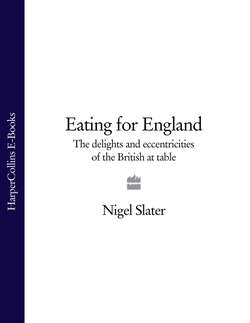Читать книгу Eating for England: The Delights and Eccentricities of the British at Table - Nigel Slater - Страница 8
Harvest Festival
ОглавлениеApart from Midnight Mass on Christmas Eve, and the time the BBC came to film Songs of Praise, my family never really went to church. Yet my father and stepmother always attended harvest festival, usually with me struggling behind with a heavy box of beans, a bag of carrots, and once a wooden crate of windfall apples from the garden.
The little stone church that sat at the bottom of the hill, and where my father’s funeral would eventually take place, would have marrows of various sizes, bundles of leeks tied with string, and bunches of dahlias the colour of wine gums stacked outside the door. Inside, loaves of bread and the produce of so many local gardens – pots of asters and bunches of chrysanthemums – were propped around the altar and tucked in the deep stone window ledges. The smell, of over-ripe damsons and yellow sunflowers, of freshly picked runner beans and home-made raspberry jam, was undercut with a sharp beery smell from the newly harvested hop fields (the church was in the middle of the Hereford–Ledbury–Bromyard hop triangle). I remember feeling that there could be nothing more beautiful than an English church decorated for harvest home. I can’t help thinking we still do harvest festival well, although it’s a pity that pensioners now insist on bringing tins of Heinz beans. A marrow would be much more pleasing, though presumably a bugger for the old dears to fit in their handbags.
I have always wondered why the sight of a place of worship decorated for harvest thanksgiving is so distinctly British, or at least not especially European. I recently clicked that it is the turning colour of the trees in the churchyards, the honey, orange and deep red leaves, that make the festival so much prettier than it is in warmer climates, whose trees are mostly evergreen (save possibly Vermont, though I have never been there). It is the whole picture, of harvested vegetables, bunches of spiky orange and pink dahlias, and the turning trees that make this a picture of Britain to treasure.
It hasn’t always been so. The only reason the Church got involved was to bring a little order to the rampant frolicking and drunkenness that traditionally accompanied the end of the harvest. It may have been a time for the farmers to say thank you to their workers, but it was also a time for those who toiled in the fields to get off their faces, fight and fornicate. Then a bit of decorum was brought into the proceedings in the shape of the church thanksgiving service. There’s the bloody Victorians for you.
